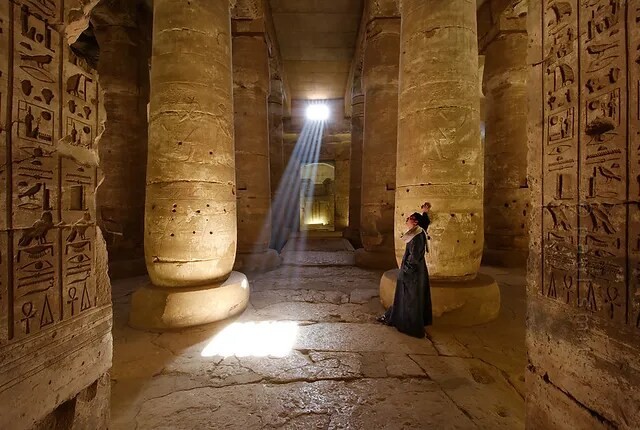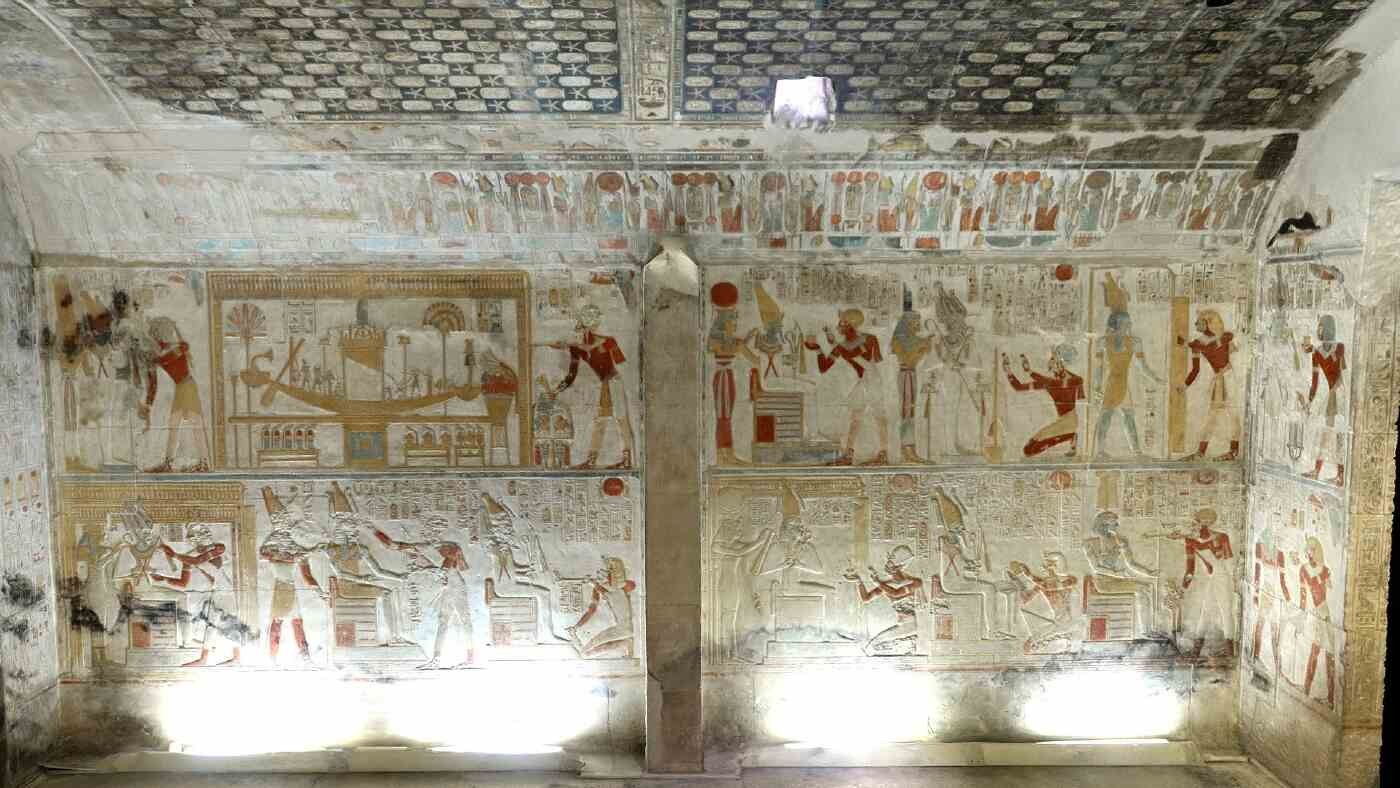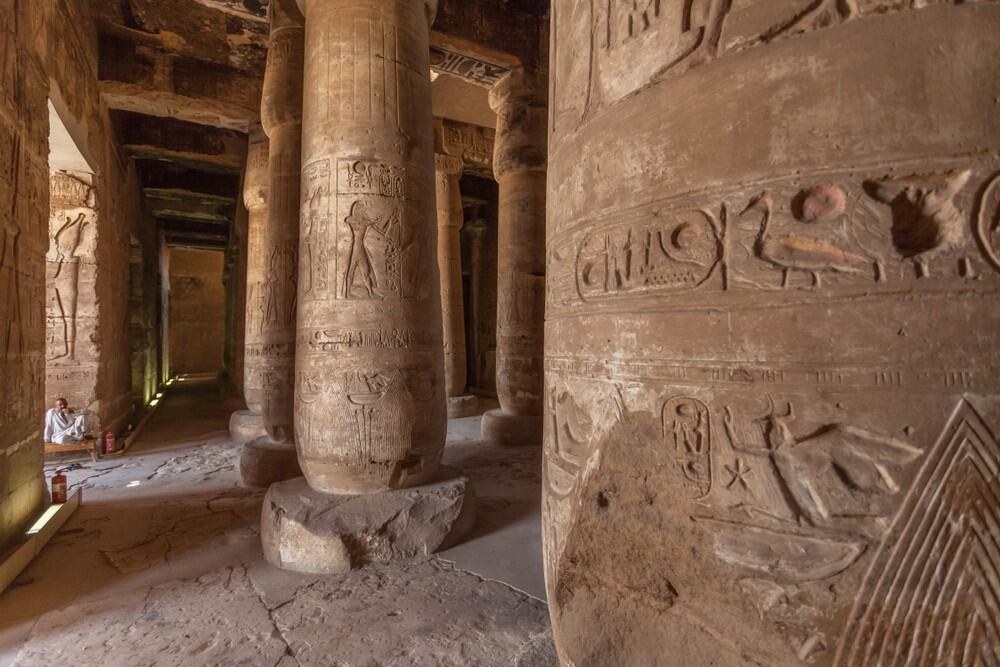On the West Bank of the Nile, not far from contemporary Sohag, is the most sacred city in all of Egypt. In ancient Egypt, the site to be buried was Abydos (also known as Ibdju), which served as the primary ritual center for Osiris, the god of the dead. The Egyptians recognised the burial site of Osiris as the tomb of King Djer, the third pharaoh of the first dynasty (c. 3000 BC). One of Egypt's most exquisite temples, which Seti I constructed during the New Kingdom, is still regarded as a national treasure.
From pre-dynastic to Christian eras (about 4000 BC - AD 600), Abydos was continuously utilised as a necropolis for more than 4500 years. The site hasn't been excavated in many areas.
The story states that Osiris's corpse was divided into parts and dispersed throughout Egypt, and that his head or according to other accounts, his phallus was buried in Abydos.
The Pre-dynastic and Early Dynastic kings of Egypt's tombs are the oldest structures in Abydos. The earliest pharaohs were buried in Abydos and hailed from a neighboring settlement. The temple of Osiris-Khentimentiu, dedicated to an ancient jackal god linked with Osiris-Khentimentiu meaning first among the westerners (the west being designated for the dead), and emphasises Osiris's function as the first among the living. These are the earliest ruins still standing today.

Early dynasty royal tombs as well as a number of wooden boats have been found during excavations. Djer, a mud-brick tomb of the First Dynasty ruler, was formerly believed to be Osiris's grave. This could have helped the religion of Osiris become more well-known. The OSIREION chapel, which was built out of massive granite blocks and is said to be Osiris's fictitious tomb or cenotaph, is the most spectacular monument to him in Abydos. People visited Abydos on pilgrimages throughout the Middle Kingdom (2055 - 1650 B.C), and many of them left steles offering tablets for Osiris inscribed with their names and prayers.
The mortuary temple of Seti I was constructed mostly of limestone, with sporadic usage of sandstone in various locations throughout the edifice, and has a distinctive L-shaped ground plan. After Seti I passed away, his son Ramesses II finished the temple. Ramesses II's cartouches may be seen in several areas of the temple, along with his distinctive sunk relief style, which contrasts with his father's extremely beautiful raised relief.
The temple's northeast entrance is through a huge pylon that has since been demolished, and it leads onto the first open court, which has likewise suffered significant damage. The second court is accessible by three entrances at the back of the pillared hall from a raised terrace reached through a staircase ramp on the temple's principal axis. Ramesses II adorned the courtyards with representations of the Battle of Kadesh and the King making a gift to the Gods. To reach the elevated terrace with the covered portion of the temple, use another stairway ramp. Seven gates, all except the central one of which were shut by Ramesses II, constitute the front and entrance to the first hypostyle hall. The portico is supported by pillars. Twelve pairs of sandstone papyrus columns with blossom capitals decorate the hall. The second hypostyle hall, which has 36 columns similar to those in the first hypostyle hall, is accessible by another seven gates. Seti I is seen bending down before the gods in the elegantly furnished hall.

Seven chapels honouring the gods Seti I (in his deified form), Ptah, Re-Hor-Akhty, Amun-Re, Osiris, Isis, and Horus may be found in the second hypostyle hall. These shrines were probably among the first parts of the temple to be adorned, and based on their stage of completion, they were probably finished before Seti I passed away. These chapels are adorned with representations of the king making a sacrifice to the gods and receiving from them symbols of dominance and life as well as regal insignia. The ceremonies that priests would have carried out behind the chapels' walls to change the monarch into the deity of death and resurrection, Osiris, would have complimented these displays.
The Osiris chapel opens up onto a transverse Osiris-cult complex with two halls and two sets of chapels. The gods Osiris, Isis, and their son Horus are honoured in the three little chapels to their right of the entrance hall. In the religion of the ancient Egyptians, the monarch who was alive symbolised Horus on earth, and after his death, he changed into Osiris, king of the underworld. The mysteries of Osiris were performed in the hidden room with two pillars behind these three chapels, which could only be entered by the top priests.
Other chapels can be seen in the southern portion of the temple, including those dedicated to the gods Ptah-Sokar and Nefertem, as well as the unfinished "Hall of the Butchers" and "Hall of the Barques" (where the barks that carried the gods' statues during rituals were maintained) (the temple slaughterhouse). There is also a part here known as the "Gallery of the Ancestors," which houses the well-known Abydos King List. It is assumed that this is where the rites of the temple would have begun. The little chapel of Osiris was then reached after a procession of priests had passed through the other six chapels. By the rites, Seti I, the deceased monarch, was changed into the deity Osiris, with whom the dead Egyptian rulers were associated.
Find out our latest news, promotions, and professional tips. Know before you book your next Egypt tours
Egypt has many historical sites that you can visit and enjoy. Each tour is different and unique. If you go on a Nile cruise, you can visit Abu Simbel, Aswan, and Luxor in the South and enjoy the temples, tombs, and the treasures of the Nile. In the North, enjoy the Pyramids of Giza, The Egyptian Museum, Sakkara. Mosques, churches in Cairo, and many landmarks located in the city of Alexandria. On the East, Enjoy a beach tour for diving, snorkeling, and swimming in the Red sea. Every city has its charm, history, and flavor where you can do many tours and activities.
Your Egypt Tours is one of Egypt’s leading and most trusted travel agencies, known for its personalized service and expert care. As a top-rated company for Egypt tour packages, we ensure every Egypt trip is safe, seamless, and unforgettable, offering competitive prices, excellent customer service, and the highest standards of quality. With us, you’re always in good hands.
The average cost of a one-week trip in Egypt is around 1600 USD, including visits to tombs, temples, and a Nile cruise. Prices vary depending on the Egypt tours and the level of luxury you choose.
It’s not recommended to drink tap water in Egypt, as it’s highly chlorinated and may cause stomach issues for travelers. During your Egypt tours, it’s best to drink bottled water and use tap water only for washing or brushing your teeth.
The best time to enjoy Egypt tours is from September to March, when the weather is mild and pleasant. During these months, temperatures are ideal for sightseeing and Nile cruises. Summer (May to September) can be very hot, but it’s also a good time for budget travelers.
Egypt is generally hot and sunny most of the year, with winter falling between November and January, and summer peaking from June to August. Winters are mild, while summers can get very hot, especially in Luxor and Aswan. The pleasant weather from September to March makes it the best time to enjoy Egypt tours and explore the country's top attractions comfortably.
Yes, Egypt is a very safe country to visit, with a low crime rate and strong security measures in all tourist areas. The government ensures that accommodations and attractions remain clean and well-monitored for travelers’ comfort. When you book Egypt tours, you’ll find professional guides and organized arrangements that make your trip worry-free and enjoyable.
Egypt offers adventures for every traveler. Explore the majestic Pyramids of Giza, sail along the Nile on a Luxury cruise between Luxor and Aswan, and discover ancient temples and tombs that tell the story of the Pharaohs. Dive or snorkel in the Red Sea at Hurghada and Sharm El Sheikh, or enjoy a relaxing beach escape. Book one of our Egypt tours to experience the perfect mix of history, culture in one unforgettable journey.
Yes, you can, summer is still a great time to explore Egypt! While temperatures can rise to around 45°C, seaside resorts like Hurghada, Sharm El Sheikh, and Marsa Alam offer refreshing escapes with diving and snorkeling opportunities. Sightseeing in the early morning or evening helps you avoid the midday heat. Summer also brings great deals on hotels and services, making it ideal for travelers on a budget. Whether you’re seeking relaxation or adventure, Egypt tours during summer can still be an enjoyable and memorable experience.
Egypt has a modest dress code, especially for women, since it’s a Muslim country. Light, comfortable clothing is fine, but avoid short shorts or skirts. When visiting religious sites, cover your shoulders and knees. During Egypt tours, you can dress casually and comfortably; formal wear is optional unless you want to make your Nile cruise dinner extra special.
You can easily obtain a visa upon arrival at Cairo Airport, the process is simple for USA, UK, Canadian, Australian, and European citizens. The visa costs $25 USD and can be purchased at the visa office before immigration. You can also apply for an E-Visa through the official portal: www.visa2egypt.gov.eg. During your Egypt tours, our team can assist you with all visa-related inquiries to make your arrival smooth and stress-free.
Your Egypt Tours travel agency recommends two weeks so that you can enjoy the temples and tombs of Luxor and Aswan, explore the sights of Cairo, and relax in the Red Sea islands and nature reserves.
The best Egypt Nile River cruise depends on your preferences, budget, and how many nights you wish to spend on board. For a truly unforgettable experience, we recommend a 5-star luxury Nile cruise that offers exceptional comfort and service. If you prefer a more private and intimate journey, choose a Dahabiya Nile cruise, ideal for small groups of around 15 people. For adventurous travelers, the traditional Felucca boats provide a simple and authentic way to sail the Nile during your Egypt tours, though they offer fewer amenities.
The best time to visit Egypt is generally from October to April where it is suitable for outdoor activities and sightseeing.
Egypt travel usually have guided tours to archaeological sites, museums, and historical landmarks. Also have optional activities may include hot air balloon rides over Luxor, snorkeling in the Red Sea, or desert safaris.
